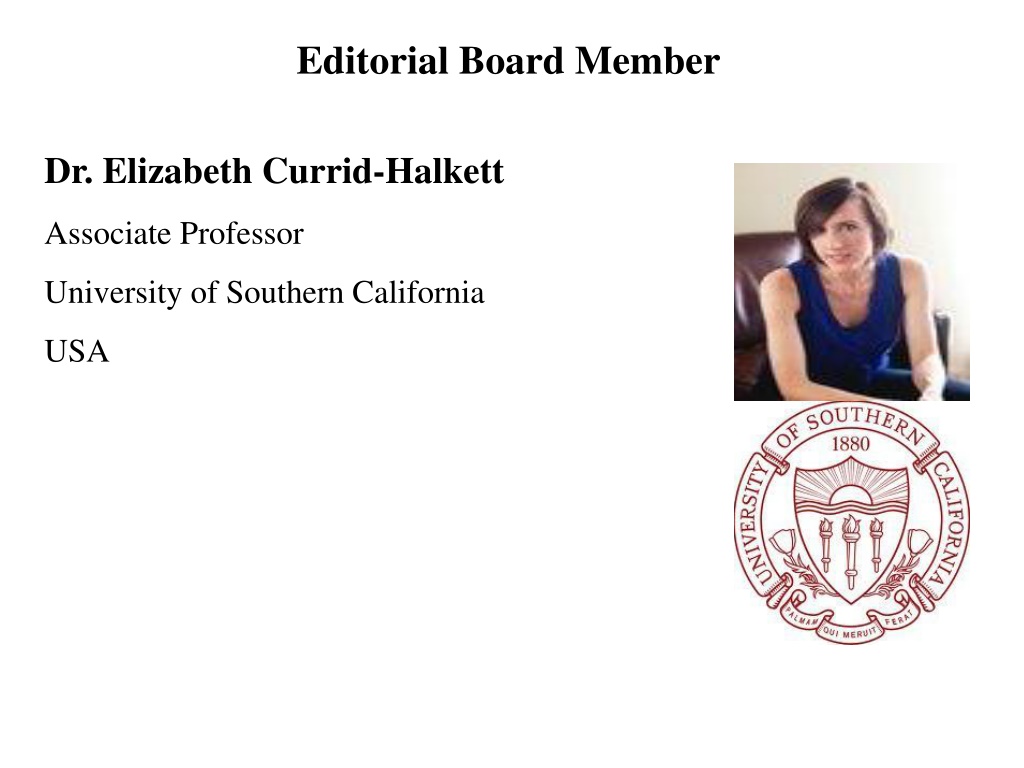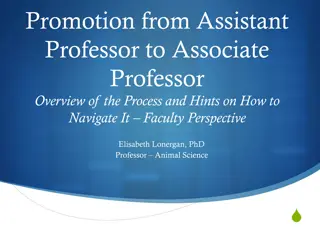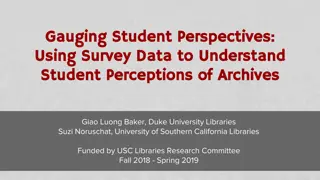Dr. Elizabeth Currid-Halkett: Associate Professor at USC
Dr. Elizabeth Currid-Halkett, an Associate Professor at the University of Southern California, specializes in economic development, the arts, and cultural industries. With an impressive publication record, her work explores the intersection of urban policy, economic geography, and social networks, shedding light on the dynamics of economic growth and social well-being. Her research interests include cities, art, and conspicuous consumption. Notable for her contributions to prestigious publications, Dr. Currid-Halkett continues to advance knowledge in her field, making significant strides in understanding the complexities of economic development and its impact on society.
Download Presentation

Please find below an Image/Link to download the presentation.
The content on the website is provided AS IS for your information and personal use only. It may not be sold, licensed, or shared on other websites without obtaining consent from the author.If you encounter any issues during the download, it is possible that the publisher has removed the file from their server.
You are allowed to download the files provided on this website for personal or commercial use, subject to the condition that they are used lawfully. All files are the property of their respective owners.
The content on the website is provided AS IS for your information and personal use only. It may not be sold, licensed, or shared on other websites without obtaining consent from the author.
E N D
Presentation Transcript
Editorial Board Member Dr. Elizabeth Currid-Halkett Associate Professor University of Southern California USA
Biography Elizabeth Currid-Halkett is associate professor at USC s Sol Price School of Public Policy. She teaches courses in economic development and urban policy and planning. Her research is in economic development with a particular focus on the arts and culture. She is the author of The Warhol Economy: How Fashion, Art and Music Drive New York City (Princeton University Press 2007) and Starstruck: The Business of Celebrity (Faber & Faber/Farrar, Straus and Giroux, 2010). > > >
Currid-Halketts work has been featured in the New York Times, Wall Street Journal, Salon, the Economist, the New Yorker, and the Times Literary Supplement, among others. She has contributed to a variety of academic and mainstream publications including the Journal of Economic Geography, Annals of the Association of American Geography, Economic Development Quarterly, the Journal of the American Planning Association, the New York Times, Harvard Business Review and the Times of London. She is currently writing a book on the evolution of conspicuous consumption, forthcoming with Princeton University Press. Currid-Halkett received her PhD from Columbia University.
Research Interests Economic development, Economic geography, Art, Cultural industries, Social networks, Cities > > >
Publications E Currid (2006) New York as a global creative hub: a competitive analysis of four theories on world cities. Economic Development Quarterly 20 (4), 330-350
Economic Development Economic development is the sustained, concerted actions of policy makers and communities that promote the standard of living and economic health of a specific area. Economic development can also be referred to as the quantitative and qualitative changes in the economy.
Such actions can involve multiple areas including development of human capital, critical infrastructure, regional competitiveness, environmental sustainability, social inclusion, health, safety, literacy, and other initiatives. Economic development differs from economic growth. Whereas economic development is a policy intervention endeavor with aims of economic and social well-being of people, economic growth is a phenomenon of market productivity and rise in GDP. Consequently, as economist Amartya Sen points out: economic growth is one aspect of the process of economic development.
Economic geography Economic geography is the study of the location, distribution and spatial organization of economic activities across the world. It represents a traditional subfield of the discipline of geography. However, in recent decades, many economists have also approached the field in ways more typical of the discipline of economics.
Economic geography has taken a variety of approaches to many different subject matters, including but not limited to the location of industries, economies of agglomeration (also known as "linkages"), transportation, international trade, development, real estate, gentrification, ethnic economies, gendered economies, core-periphery theory, the economics of urban form, the relationship between the environment and the economy (tying into a long history of geographers studying culture-environment interaction), and globalization.
Social networks A social network is a social structure made up of a set of social actors (such as individuals or organizations) and a set of the dyadic ties between these actors. The social network perspective provides a set of methods for analyzing the structure of whole social entities as well as a variety of theories explaining the patterns observed in these structures. The study of these structures uses social network analysis to identify local and global patterns, locate influential entities, and examine network dynamics.
Social networks and the analysis of them is an inherently interdisciplinary academic field which emerged from social psychology, sociology, statistics, and graph theory. Georg Simmel authored early structural theories in sociology emphasizing the dynamics of triads and "web of group affiliations." Jacob Moreno is credited with developing the first sociograms in the 1930s to study interpersonal relationships. These approaches were mathematically formalized in the 1950s and theories and methods of social networks became pervasive in the social and behavioral sciences by the 1980s. Social network analysis is now one of the major paradigms in contemporary sociology, and is also employed in a number of other social and formal sciences. Together with other complex networks, it forms part of the nascent field of network science.
Thank You..! Thank You..!























